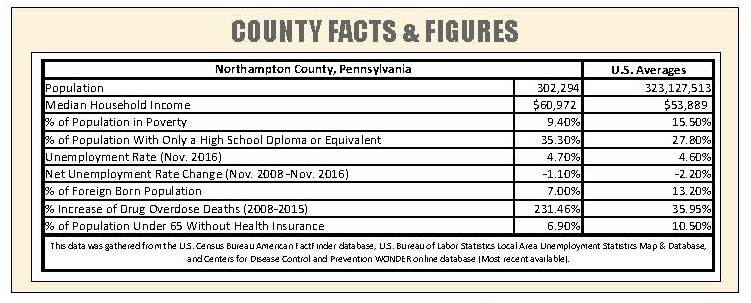“There is a growing weariness with Trump’s penchant to shoot himself in the foot.”

At first glance, Northampton County, Pennsylvania might not seem like “Trump Country.” Despite some remnants of the steel industry that once dominated the local economy, there are few obvious indicators of the Rust Belt settings that were at the heart of Donald Trump’s electoral triumph in 2016.
At the time of the election last November, the unemployment rate in the county was 4.7%, well below the state rate of 5.4%, and the median family income in the county was about $8,000 above the national level. The local economy displays many of the staples of a flourishing contemporary economy with “eds and meds” prominently represented. Finally, Northampton County hadn’t gone Republican in a presidential election since 1984, with Barack Obama winning by 12 points in 2008 and 5 points in 2012.
While not a prototypical Trump area, Northampton County nevertheless was one of only three counties in Pennsylvania that Trump carried and Mitt Romney did not. Trump’s 4 point win in this county at the eastern tip of Pennsylvania was crucial in his narrow victory over Hillary Clinton, helping him secure the Keystone State’s 20 electoral votes. But over a half year removed from Trump’s victory in Northampton County, his standing among the voters that helped place him in the White House shows signs of wear as the president’s embattled administration tries to find its footing.
There are signs of fatigue with the president’s lack of focus on issues such as tax reform and infrastructure investment and his seeming addiction to social media.
As with most of the country, Trump voters in Northampton county seem to have generally stood by the President through his tumultuous first few months in office. Discussions with the area’s Trump voters usually demonstrate a willingness to give the president time to achieve policy success. When pushed regarding the president’s struggles during the early stages of his administration, Trump’s Northampton County voters tend to emphasize the challenges and obstacles that he faces. They point to a hostile mainstream media and leaks from federal employees as primary causes of President Trump’s inability to move faster and more successfully on his agenda.

But while Trump’s supporters lay a majority of the President’s struggles on a combination of a biased and blood thirsty media, an entrenched bureaucratic state, and an ineffective Congress, there are signs of disappointment and frustration with elements of Trump’s performance in the White House. The most common criticism of the president is his tendency to do damage to himself. There is a growing weariness with Trump’s penchant to “shoot himself in the foot” with unsubstantiated claims and bombastic attacks. Among his voters in Northampton County, there are signs of fatigue with the president’s lack of focus on issues such as tax reform and infrastructure investment and his seeming addiction to social media.
One Trump supporter captured this frustration when he said, “I just want the President to talk less and do more.” This frustration seems to be most significant among the substantial number of voters that gave Trump their vote last November in spite of his personal flaws with the hope that he might be able to get things done in Washington in areas that they care about.

For example, Northampton County is just the type of place where a major infrastructure bill has broad appeal. The area’s location just east of New York City and north of Philadelphia has helped turn it into a major transportation and logistical center with warehouses and terminals for major companies like Amazon and FedEx dotting the landscape. The increased truck and rail traffic has strained the county’s aging transportation system, and the state and local governments who are weighed down by fiscal pressures have struggled to finance the infrastructure repairs and improvements needed. It is interesting to imagine what may have been if Trump’s first major initiative in office was to put forth the infrastructure initiative that he called for on the campaign trail and seems to be inching towards six months into his presidency. In Northampton County, it certainly would have been a great fit — not only among his strongest supporters, but also among some of the voters who took a chance on him last November and now may be harboring doubts about their decision.
If the Trump electoral coalition does begin to come apart, the canary in the coal mine is likely to be Northampton County, Pennsylvania.
Notably, most of Northampton County is represented in Congress by the emerging face of moderate Republicanism – Congressman Charlie Dent. Over the course of the 2016 election season and through the first months of Trump’s presidency, Dent has been a vocal critic of Trump on many issues and a “no” vote on the White House backed American Health Care Act. Dent won by 17 points in the Northampton County portion of his district in 2016, and in many ways seems to be a more natural fit in style and substance for the voters of the area than his fellow Republican at 1600 Pennsylvania Avenue. It will be interesting to see if Northampton County Republicans can support both Trump and Dent, or if it has in essence become a zero-sum game in which one’s success will imply failure for the other.
If the Trump electoral coalition does begin to come apart, the canary in the coal mine is likely to be Northampton County, Pennsylvania. An election map of Pennsylvania shows Northampton County to be surrounded by counties that Hillary Clinton carried, leaving Northampton an island of Trump electoral strength. But as waves develop in politics, as in oceans, islands are often the places that feel the changes first and most directly. Thus, if Trump cannot maintain support in this area of Pennsylvania, it will be hard to see how he will have enough public backing nationally to maintain leverage in Congress to get key elements of his policy agenda passed into law.
Christopher P. Borick, Ph.D., is a Professor of Political Science and the Director of the Muhlenberg College Institute of Public Opinion.




